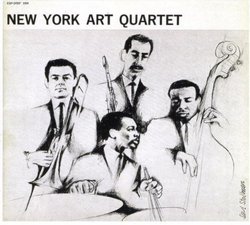NEW YORK ART QUARTET
Stuart Jefferson | San Diego,Ca | 12/25/2008
(4 out of 5 stars)
"One disc 43 minutes approximately. Digitally remastered-the sound is clean with good spatial separation among the instruments. This recording features Roswell Rudd-trombone,John Tchicai-alto sax,Lewis Worrell-bass,Milford Graves-drums and percussion,and on track two-Amiri Baraka(Leroi Jones)who recites a poem over a subtle background of music. The poem is strictly out of the sixties and is an example of how jazz was used in conjunction with the spoken word,and is valuable for that reason. This track is also the shortest on this set,about three and a half minutes. The music on the rest of the tracks is unstructured and atonal.
This is a perfect example of "outside" music that was touted as "the new thing" in the sixties. Fans of this style of jazz will find much to their liking here. The first track is used as a setting of style for the rest of the tracks. Track three starts off hesitantly but quickly finds a groove(if this music can have a groove),and finds all the players using their instruments to weave a subtle pattern of sound. The other tracks find the players playing over,with,and against each other-either "all-out" or with great subtly. The presence of Milford Graves on these sides gives this music a good grounding-he never lets things get out of hand. The same could also be said of Lewis Worrell-his bass playing,both within the group and on solos, is always just right. As for Rudd and Tchicai,their playing is always intelligent combined with a real feel for the music. Being totally subjective here,it seems to these ears and mind that each track,starting with track three,gets better and better. There is a subtly and a deep feeling in the music,that seems to increase. By the time the music has ended,there is a feeling of wanting more,or not wanting the music to end. On reflection,isn't that what we want in a listening experience?
The notes are short and to the point. Rudd formed this group for an afternoon recording session. They were joined by Baraka. The group played again forty years later,opening for a Sonic Youth concert at Thurston Moore's invitation. As it seems to happen,Worrell had vanished from the scene and was replaced by Reggie Workman on bass. This is another example of why ESP RECORDS was,and continues to be important. From the music,to the album graphics-this is a nice package. It's good to hear it again and again. For more good music of this sort,look for NEW YORK EYE AND EAR CONTROL on ESP RECORDS."


 Track Listings (6) - Disc #1
Track Listings (6) - Disc #1